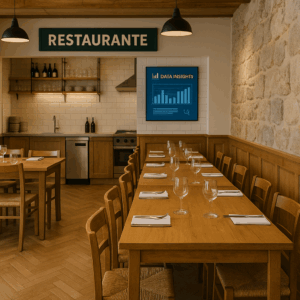Families represent one of the most valuable, year-round customer groups in foodservice. This report explores the state of family dining in Portugal, revealing major gaps in how restaurants serve this segment—and the measurable advantages for those that do.
DIG‑IN data shows that most Portuguese restaurants are not family-optimized—missing out on consistent, high-value demand from parents and children alike.
Restaurants Miss Family Market
Only 33% of venues are effectively family-optimized
Higher Engagement
Family-friendly venues earn higher customer engagement
Revenue Premium
Higher per-table revenue through larger groups
The Family Dining Disconnect
Portugal’s restaurant sector continues to grow—but it’s missing one of its most consistent, high-impact customer segments: families. DIG‑IN’s analysis of 178 restaurant categories reveals that only 33% of venues are effectively optimized for family dining experiences.
The impact is measurable: those that are family-friendly earn 23% higher engagement, with stronger repeat visit patterns and higher average ticket values. Yet, 67% of restaurants still fail to offer the environment, menu, or service design required to meet the needs of multi-age group dining.
Why Families Matter—And Why the Gap Is Growing
From weekday dinners to weekend outings, families represent predictable, repeatable, and influential dining occasions. But the disconnect lies in how the market sees them: too often treated as niche or seasonal, rather than essential.
Back-to-School as a Catalytic Moment
While the demand is year-round, back-to-school acts as a trigger point:
- Kids are on summer break and parents are managing activity-filled days
- Meal routines are re-established before the academic year starts
- Dining out becomes a reward for completing errands or handling transitions
DIG‑IN’s August data shows a significant lift in family dining engagement during this time, suggesting it’s the ideal moment for restaurants to initiate or relaunch family-friendly positioning that lasts beyond September.
Patterns seen in Portugal reflect broader international findings, such as those from the National Restaurant Association, showing family dining as a reliable revenue driver year-round.
What Families Want—And What Restaurants Miss
Family dining behavior differs sharply from solo, couple, or peer-group outings:
- Convenience trumps complexity: quick, clear menus and fast service win
- Group sizes fluctuate: from parent-child duos to full multi-gen tables
- Value is scrutinized: especially during high-expense periods like school prep
- Flexibility is essential: high chairs, food substitutions, early hours, noise tolerance
DIG‑IN’s segmentation data also shows strong regional variation:
- Urban families seek speed and simplicity
- Suburban and rural families prefer space and stay time
- Tourism zones see high demand from domestic and international family travelers
The 33% Family-Optimized Advantage
Restaurants that serve this audience well enjoy:
- 23% higher engagement in summer and year-round
- 18% higher per-table revenue through larger group sizes and bundled ordering
- Loyalty dividends as families form habits and repeat weekly or monthly
The competitive gap isn’t just seasonal—it’s structural. And it’s widening.
What Family-Optimized Looks Like
Top-performing restaurants in this space tend to offer:
- Seating flexibility: tables for 4–8, child seating, and group accommodations
- Streamlined menus: fast reads, options for every age, and bundled value meals
- Noise-tolerant environments: acoustic planning and activity kits or engagement tools
- Service designed for parents: speed, empathy, and the ability to pivot between kids and adults
Menu-wise, DIG‑IN finds that:
- Shared-plate formats reduce cost and friction
- Cold drink and dessert options are essential to “treat” moments
- Clear allergy info builds trust with cautious parents
Technology Supports the Family Experience
Tech has emerged as a key enabler for this segment:
- Mobile pre-ordering minimizes time-to-meal for parents with toddlers
- Table management tools allocate appropriate seating for kids and carriers
- Allergy and dietary tracking allow families with special requirements to order with confidence
- Text/app updates smooth wait times and reduce stress during high-traffic hours
When used well, technology amplifies hospitality without replacing the human touch—a winning combo for this customer group.
A Missed Opportunity with Year-Round Potential
While family dining often spikes in August and December, DIG‑IN data shows sustained demand throughout the year:
- Fridays and Sundays are high-opportunity windows for family groups
- Post-school hours (5–7 PM) see spikes in urban areas
- Long-weekend and holiday eves consistently outperform average visit durations and ticket size
Yet, 67% of restaurants still treat family-friendly as seasonal—when the top third prove it’s a profitable permanent strategy.
Conclusion: The Family Dining Imperative
DIG‑IN’s data leaves little room for doubt: Portuguese restaurants are under-serving the family dining in Portugal and are leaving revenue, loyalty, and long-term brand equity on the table.
Getting this right during high-visibility moments like the August transition period creates a launchpad for sustained engagement all year. The question isn’t whether family optimization matters—it’s whether operators are willing to commit to it before their competitors do.
For more insights on how restaurants can optimize their operations for different customer segments, see our analysis of extended hours opportunities and climate-adaptive restaurant design.
Analysis based on DIG‑IN’s comprehensive review of 178 restaurant categories and family dining engagement patterns across Portugal.




